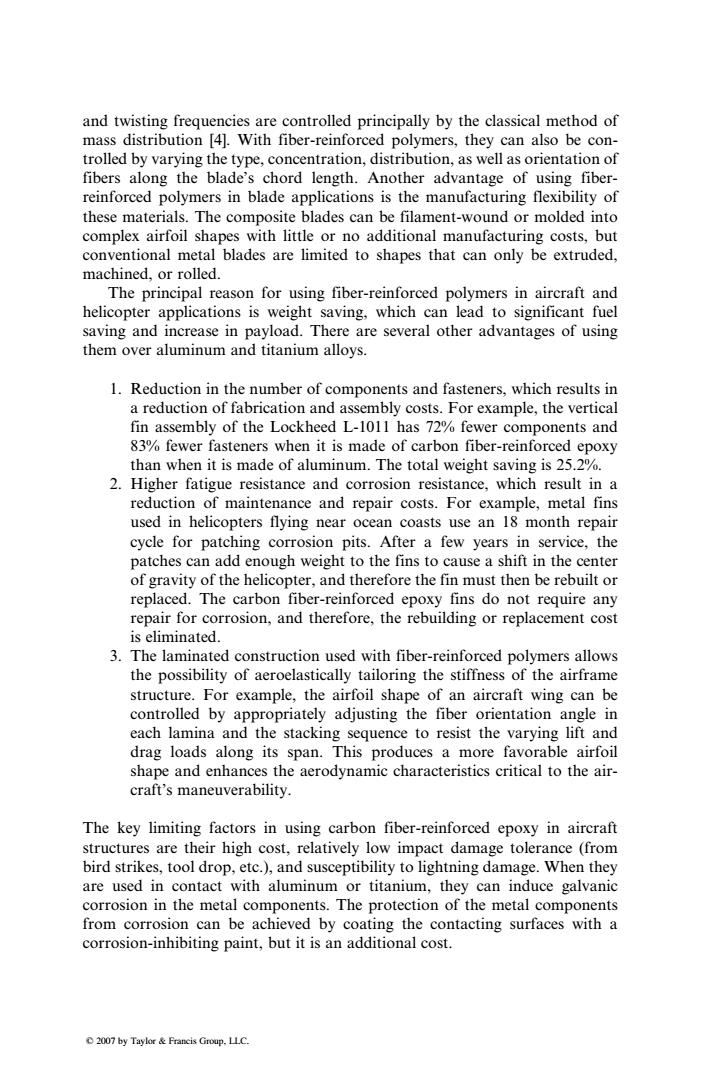正在加载图片...

and twisting frequencies are controlled principally by the classical method of mass distribution [4].With fiber-reinforced polymers,they can also be con- trolled by varying the type,concentration,distribution,as well as orientation of fibers along the blade's chord length.Another advantage of using fiber- reinforced polymers in blade applications is the manufacturing flexibility of these materials.The composite blades can be filament-wound or molded into complex airfoil shapes with little or no additional manufacturing costs,but conventional metal blades are limited to shapes that can only be extruded, machined,or rolled. The principal reason for using fiber-reinforced polymers in aircraft and helicopter applications is weight saving,which can lead to significant fuel saving and increase in payload.There are several other advantages of using them over aluminum and titanium alloys. 1.Reduction in the number of components and fasteners,which results in a reduction of fabrication and assembly costs.For example,the vertical fin assembly of the Lockheed L-1011 has 72%fewer components and 83%fewer fasteners when it is made of carbon fiber-reinforced epoxy than when it is made of aluminum.The total weight saving is 25.2%. 2.Higher fatigue resistance and corrosion resistance,which result in a reduction of maintenance and repair costs.For example,metal fins used in helicopters flying near ocean coasts use an 18 month repair cycle for patching corrosion pits.After a few years in service,the patches can add enough weight to the fins to cause a shift in the center of gravity of the helicopter,and therefore the fin must then be rebuilt or replaced.The carbon fiber-reinforced epoxy fins do not require any repair for corrosion,and therefore,the rebuilding or replacement cost is eliminated. 3.The laminated construction used with fiber-reinforced polymers allows the possibility of aeroelastically tailoring the stiffness of the airframe structure.For example,the airfoil shape of an aircraft wing can be controlled by appropriately adjusting the fiber orientation angle in each lamina and the stacking sequence to resist the varying lift and drag loads along its span.This produces a more favorable airfoil shape and enhances the aerodynamic characteristics critical to the air- craft's maneuverability. The key limiting factors in using carbon fiber-reinforced epoxy in aircraft structures are their high cost,relatively low impact damage tolerance(from bird strikes,tool drop,etc.),and susceptibility to lightning damage.When they are used in contact with aluminum or titanium,they can induce galvanic corrosion in the metal components.The protection of the metal components from corrosion can be achieved by coating the contacting surfaces with a corrosion-inhibiting paint,but it is an additional cost. 2007 by Taylor&Francis Group.LLC.and twisting frequencies are controlled principally by the classical method of mass distribution [4]. With fiber-reinforced polymers, they can also be controlled by varying the type, concentration, distribution, as well as orientation of fibers along the blade’s chord length. Another advantage of using fiberreinforced polymers in blade applications is the manufacturing flexibility of these materials. The composite blades can be filament-wound or molded into complex airfoil shapes with little or no additional manufacturing costs, but conventional metal blades are limited to shapes that can only be extruded, machined, or rolled. The principal reason for using fiber-reinforced polymers in aircraft and helicopter applications is weight saving, which can lead to significant fuel saving and increase in payload. There are several other advantages of using them over aluminum and titanium alloys. 1. Reduction in the number of components and fasteners, which results in a reduction of fabrication and assembly costs. For example, the vertical fin assembly of the Lockheed L-1011 has 72% fewer components and 83% fewer fasteners when it is made of carbon fiber-reinforced epoxy than when it is made of aluminum. The total weight saving is 25.2%. 2. Higher fatigue resistance and corrosion resistance, which result in a reduction of maintenance and repair costs. For example, metal fins used in helicopters flying near ocean coasts use an 18 month repair cycle for patching corrosion pits. After a few years in service, the patches can add enough weight to the fins to cause a shift in the center of gravity of the helicopter, and therefore the fin must then be rebuilt or replaced. The carbon fiber-reinforced epoxy fins do not require any repair for corrosion, and therefore, the rebuilding or replacement cost is eliminated. 3. The laminated construction used with fiber-reinforced polymers allows the possibility of aeroelastically tailoring the stiffness of the airframe structure. For example, the airfoil shape of an aircraft wing can be controlled by appropriately adjusting the fiber orientation angle in each lamina and the stacking sequence to resist the varying lift and drag loads along its span. This produces a more favorable airfoil shape and enhances the aerodynamic characteristics critical to the aircraft’s maneuverability. The key limiting factors in using carbon fiber-reinforced epoxy in aircraft structures are their high cost, relatively low impact damage tolerance (from bird strikes, tool drop, etc.), and susceptibility to lightning damage. When they are used in contact with aluminum or titanium, they can induce galvanic corrosion in the metal components. The protection of the metal components from corrosion can be achieved by coating the contacting surfaces with a corrosion-inhibiting paint, but it is an additional cost. 2007 by Taylor & Francis Group, LLC